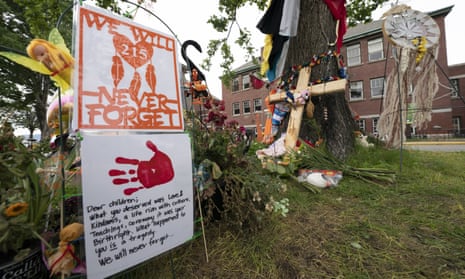Indigenous people in Canada who were forced to use European names on official documents can now apply to restore their original names, in a new policy unveiled as the country’s government seeks to atone for historical abuses.
“For far too long, Canada’s colonial legacy has disrupted Indigenous peoples’ Indigenous naming practices and family connections from being recognized,” Marc Miller, minister of Indigenous services, said in a statement, adding that the new policy would allow residents to reclaim “the dignity of their Indigenous names”.
The announcement comes as the country grapples with the discovery of hundreds of unmarked graves at the site of a former residential school, which has brought renewed focus to the country’s grim colonial past.
Beginning in the 1800s, more than 150,000 Indigenous children were taken from their homes and placed in the notorious schools, operated by religious institutions and the federal government as a means of forcible assimilation.
Children were forced to wear uniforms and learn English, boys had their braided hair cut and many were given Christian names.
In 2010, Peter Nakogee told Canada’s Truth and Reconciliation commission that he was whipped for using his traditional name.
“I got the nun really mad that I was writing in Cree. And then I only knew my name was Ministik,” he said. “From the first time I heard my name, my name was Ministik. So I was whipped again because I didn’t know my name was Peter Nakogee.”
In 2015, the commission announced 94 “calls to action” to help reconcile Indigenous peoples and Canadians, but the majority have gone unheeded.
The federal government’s recent decision to allow name changes to official documents, six years after the commission’s report, reflects the 17th call to action.
“The traditional names given to Indigenous children carry deep cultural meaning. Yet for many First Nations, Inuit and Métis people, colonialism has robbed them of these sacred names,” said Canada’s citizenship minister, Marco Mendicino. “At times, efforts to use traditional names have been met with everything from polite rejection to racism.”
The policy applies to all individuals of First Nations, Inuit and Metis background – not just residential school survivors, but also those who have been hesitant to use their traditional names in official documents.
In September, Ka’nhehsí:io Deer, a CBC journalist, wrote about her decision to return to using her traditional name after using her English name “Jessica” in a professional capacity.
“There’s always been hurdles in the process of having my name spelled with the correct diacritic marks on just about every piece of personal identification. For example, a colon has become an invalid character on Canadian passports, nor can it be used in email addresses or social media handles,” she wrote.
“But, to continue not using my Kanien’kéha name felt like a huge weight on my shoulders. I love my name, and I am proud of it.”
